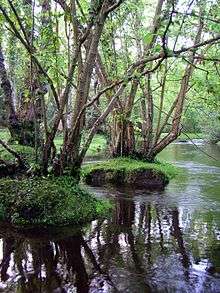Titchfield Canal
The Titchfield Canal was used to irrigate meadows in the Meon valley. The so-called canal, earlier known as the "New River", is a two-mile watercourse between the village of Titchfield, Hampshire, and the coast at Titchfield Haven adjacent to the modern nature reserve. Lying above and roughly parallel to the nearby River Meon it is plainly artificial, but its origins and purpose have been warmly debated. [1]

Three suggestions have been made as to why the "canal" was built: (a) as a navigation channel by the 3rd Earl of Southampton, (b) to supply water to water meadows, or (c) both.
That it has been used as a feeder channel for a water meadow system is beyond question. The telltale surface patterns of water meadows can still be made out in places from the path along the Canal, and are even clearer from Google Earth images. Further, the remains of a couple of the sluices through which water was admitted from the Canal to the water meadows can still be seen, and 19th century 1:2500 maps show a dozen more.
What is less clear is when the New River was built and by whom, and whether it was ever used as a navigation channel. On 24 June 1611 the parish register notes that "the same day Titchfield Haven was shutt out by one Richard Talbotts industrie under gods permisione at the costs of the right honorable the Earle of Southampton". It has been inferred from this that a dike was built across the Meon Estuary, preventing sailing vessels from entering the river and cutting off Titchfield from seaborne trade. There is certainly a dike across the Estuary now, but what in detail was done in 1611 is not known. It has been further inferred that to get around this inferred problem a substitute navigation channel in the form of the New River was built at the same time. No contemporaneous archival evidence has yet come to light to support this hypothesis; what little documentation there is suggests a land reclamation project, for which a total closure of the estuary would not necessarily be required.
There is evidence of further large works being carried out in the Meon Estuary in the 1670s. In a Chancery case starting in 1739 elderly residents testified that boats still sailed up to Titchfield in their lifetimes and only ceased to do so when the heirs of the Earl built a barrier across the river. Although they are imprecise as to date their evidence does bracket the 1670s for the final closure. Also, presentments in the Titchfield Manorial Court in 1676 show that the Lord of the Manor by cutting the New River "hath taken away and doth detain" parts of the copyholds of two tenants, John Cooper and John Landy, implying that at that time the construction of the New River was recent.
What archival evidence has so far come to light, together with the visible evidence on the ground, tends towards the agricultural explanation rather than the navigational one, but a final answer depends on the discovery of further evidence. In the meantime the book referenced below contains a number of papers by different writers discussing the various theories, and numerous source references.
See also
- Canals of Great Britain
- History of the British canal system
References
- Watts, George (2011). Titchfield: an ancient parish. Titchfield History Society. ISBN 978-0-9508131-6-5.
External links
- Fareham Borough Council, Walk Ten: Titchfield Canal
- Hampshire County Council, Painting of Titchfield Haven, at Westbury Manor Museum, Fareham
